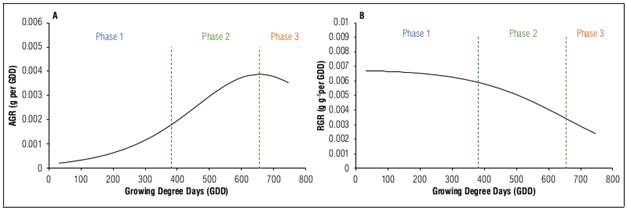INTRODUCTION
Colombia stands for as a producer and exporter of different types of flowers. Currently, it is ranked second for exporting countries, following the Netherlands. For the carnation (Dianthus caryophyllus L.), Colombia ranks first (Asocolflores, 2020). The carnation is one of the four more important cut flower species worldwide (Boxriker et al., 2017; Lin et al., 2021), and, in Colombia, the standard carnation and the mini carnation represent 15.6% of total flower production (Asocolflores, 2020). The carnation is commercially important mainly because of its beauty, wide range of flower colors (Morimoto et al., 2021), duration, availability throughout the year, and resistance to packaging and transportation (Castilla et al., 2014).
The carnation belongs to the Caryophyllaceae family. Recent carnation cultivars display a wider flower color range together with more varied flower color patterns, due to the accumulation of flavonoids in the petals (Morimoto et al., 2021). Flowers are usually perfect with four to ten stamens, a cylindrical calyx, and branched stems up to 80 cm long, with opposite leaves, productivity is 15 stems throughout the cycle (Singh et al., 2013). Genetic breeding has produced new carnations with attractive characteristics in terms of color, head size, flower shape, aroma, prolonged vase-life, and agronomic characteristics such as productivity and disease resistance (Onozaki, 2018; Lin et al., 2021). However, the physiological and phenological behavior that is related to production and quality in various carnation materials grown in Colombia is unknown.
Phenology is the study of the changes in plants from emergence to harvest maturity and how they are affected or influenced by environmental conditions, where temperature is one of the more important driving forces for development and crop growth in all phenological stages (Salazar-Gutierrez et al., 2013; Sadras and Calderini, 2021). The term thermal time combines temperature and time (López et al., 2010) and is defined as the number of degree days needed to complete a process or phenological phase (Trudgill et al., 2005; Parra-Coronado et al., 2015). Studying phenological behavior is very useful for the development of phytotechnical activities (Molinet-Salas and Lescay-Batista, 2021).
Several studies have been carried out to determine models that describe the effect of temperature on phenological development (Romero-Cuervo et al., 2022). One of the most widely used methods is the accumulation of average daily temperature above a base temperature (Tb), known as thermal time, growth or development degree-days (GDD), or heat units (López et al., 2010). Each species, cultivar or variety has different thermal requirements (Sikder, 2009). The concept assumes a direct and linear relationship between growth and temperature. Thus, GDD is the deviation of the average daily temperature above the minimum threshold or base temperature (Ahmad et al., 2017).
Growing degree-days (GDD) are used as a phenoclimatic measurement to represent changes in temperature that are relevant to different phases of plant development (Cleland et al., 2007). Degree-days are used to predict the date a flower will bloom or the date a crop will reach maturity (Lambers et al., 2008). Sikder (2009) stated that each plant has a specific temperature requirement before certain phenological stages are reached. In Dianthus caryophyllus, the formation of the flower bud and flowering indicate the precocity of a variety and directly affect production. Thus, phenological models are tools for understanding the development and growth of plants (Romero-Cuervo et al., 2022).
In ornamentals, including the carnation, few studies have defined the heat units necessary to reach a certain stage or phenological stage. López et al. (2010) developed a model for node appearance in standard carnation using the accumulation of growing degree-days. Romero-Cuervo et al. (2022) evaluated the development of flower buds from the rice point to cutting point and found that the standard carnation cv. Moon light accumulated 777.68 GDD.
The term plant growth analysis refers to a series of methodologies that describe and interpret the performance of plants grown under natural, semi-natural or controlled conditions (Hunt, 2017). This analysis is based on simple primary data such as weight, area, volume, and component contents that involve changes in the "plant" system. This study aimed to elucidate the phenological growth behavior and growing degree days of carnations in the flowering phase in the cultivars Idilio, Ilusion and Moon light under greenhouse conditions in the municipality of Toca, Colombia.
MATERIALS AND METHODS
This study was carried out on a standard carnation crop (Dianthus caryophyllus L.) in the Department of Boyaca, municipality of Toca, on the La Luisa farm of Propagar Plantas SAS, at 2,810 m a.s.l., with a geographical location of 5°33'52.1” N and 73°12'06.5” W. A minimum mean temperature inside the greenhouse of 9.6°C and a maximum mean of 30.9°C (Tab. 1). These weather data were obtained with an RHT20 humidity and temperature datalogger (Extech™).
Table 1. Mean temperatures inside the greenhouse during the study period.
| Month | Temperature (°C) | ||
|---|---|---|---|
| Maximum | Minimum | Mean | |
| February | 32.94 | 10.1 | 16.87 |
| March | 31.54 | 9.44 | 16.58 |
| April | 30.12 | 9.73 | 16.25 |
| May | 29.6 | 9.23 | 16.33 |
Ilusion, Moonlight and Idilio cultivars standard carnation plants were planted in 90% burnt rice husk as substrate, cuttings were planted with 21 d of rooting using a density of 28 plants/m2. During planting, plant tutoring was installed using five floors of mesh for flower with 11 × 11 cm2, a plant is located in each square. The meshes are separated every 15 or 20 cm as the stems grow. All the beds have a 16 mm drip tape installation, and the plants receive a complete fertigation formula with the following composition (mg kg-1): N (NO3) 172, N(NH4) 9, P 35, K+ 223, Ca2+ 150, Mg2+ 30, S 48, Fe 2, Mn 0.26, Cu 0.8, Zn 0.23, B 1.03, and Mo 0.10. Being an organoponic system, the growth of weeds is minimal, therefore, effective manual control is made. The integrated management of pests and diseases is based on the Fungicide Resistance Action Committee (FRAC) and the Insecticide Resistance Action Committee (IRAC), where a rotation of active ingredients is generated according to their mechanism and mode of action.
Standard carnation plants from tree varieties that were 22 weeks old and in good phytosanitary condition were used. 150 stems of each variety were selected and marked. The number of marked samples was overestimated to counteract mechanical losses or phytosanitary problems. These stems were in the "rice" stage, the initial phase (Arévalo et al., 2007).
The stems were marked and randomly chosen within the same production bed. According to the BBCH scale (Meier, 1997), the study included the main growth stage 5 (Appearance of the floral organ) and part of the growth stage 6 (Flowering). However, sampling was done according to the eight phenological stages of flower bud formation, which are commonly used in Colombian floriculture (Arévalo et al., 2007; Romero-Cuervo et al., 2022): rice, pea, chickpea, barrel, star, bullet, cut-off point 3, and cut-off point 5. Photographic records were kept for each state. Each sample unit had 10 stems, and the fresh mass and dry mass were quantified at each sampling point. A second evaluation was repeated 2 months later under the same conditions to obtain more precise data.
The following variables were determined: for fresh mass, 10 stems cut at the first internode after the flower bud were taken and individually weighed using an Acculab® VIC612 precision balance to the nearest 0.01 g; and, for the dry mass, 10 stems taken at each sampling point were subjected to a drying process at 75°C using a Memmert®UN30plus drying stove.
The absolute growth rate (AGR) (Eq. 1) and the relative growth rate (RGR) (Eq. 2) were calculated with the data obtained using the following formulas (Hunt, 2017)
Where, W was total dry mass (g) and dW/dt the variation of dry mass as a function of thermal time.
The accumulation of growth degree-days (GDD) (Eq. 3) was determined using the residual method (Romero-Cuervo et al., 2022)
Where, Tm was the mean daily air temperature, calculated by taking the daily temperature every 30 min with a RHT20 humidity and temperature datalogger (Extech™).
The base temperature (Tbase) or critical point of the crop is the temperature at which metabolic and physiological processes begin to be affected. The base temperature was set at 0.12°C according to López et al. (2010).
A descriptive analysis was carried out to determine the standard and average error for each of the identified stages. The growth curves and their phases were estimated with non-parametric logistic models for each of the varieties using the sicegar package of R Core Team (2022). The absolute growth rate and relative growth rate were determined using a functional growth analysis and the parameters estimated with the logistic models.
RESULTS
Phenology
In the rice stage, the first pair of leaves completely covered the main button in the three cultivars (Fig. 1, 2, and 3). In this stage, the precocity of a cultivar is determined. ‘Moon light’ first developed the rice point in most of its stems, followed by ‘Idilio’ and finally ‘Ilusion’.
For the pea stage, the bracts separated a little and gave way to the calyx, the sepals were not differentiated, and petals were formed internally (Fig. 1, 2, and 3). This stage presented an accumulation of 133.8 GDD (8 d) for ‘Ilusion’; the other two varieties were earlier (Tab. 2). The chickpea stage had a shorter duration in ‘Ilusion’, followed by ‘Idilio’ and finally ‘Moon light’ (Tab. 2). In the three cultivars, the petals are formed internally, are small but influence the size of the calyx, keeping their pale green color. The sepals then differentiated (Fig. 1, 2 and 3). In the barrel stage, the sepals opened and allowed the emergence of the corolla formed by the petals; the Moon light cultivar began to define its color, while the petals of ‘Idilio’, and ‘Ilusion’ remained pale green (Fig. 1, 2, and 3). However, ‘Idilio’ had the lowest accumulation of degree-days (194.1 GDD, 12 d; Tab. 2).
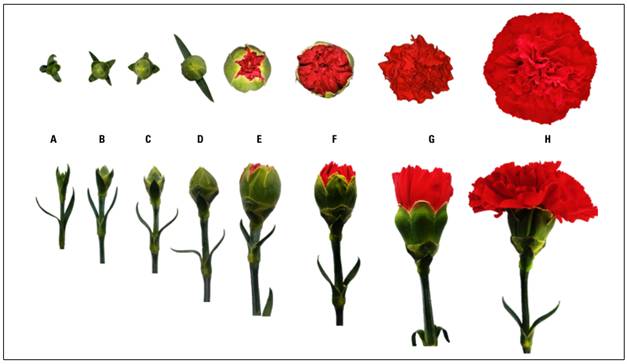
Figure 1. Development stages for flower buds in standard carnation (Dianthus caryophyllus L.) cultivar Idilio. A: rice; B: peas; C: chickpea; D: barrel; E: star; F: bullet; G: cut point 3; H: cut point 5.
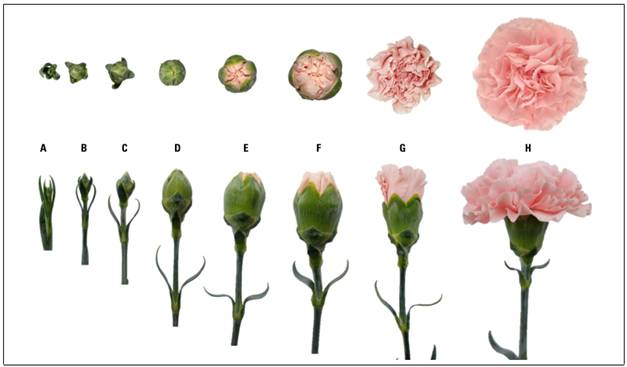
Figure 2. Development stages for flower buds in standard carnation (Dianthus caryophyllus L.) cultivar Ilusion. A: rice; B: pea; C: chickpea; D: barrel; E: star; F: bullet; G: cut point 3; H: cut point 5.
Table 2. Duration of the phenological stages of the flower bud for three carnation (Dianthus caryophyllus) cultivars grown under greenhouse.
| Phenological stages | ‘Idilio’ | ‘Ilusion’ | ‘Moon light’ | |||
|---|---|---|---|---|---|---|
| GDD | Days | GDD | Days | GDD | Days | |
| Rice | - | - | - | - | - | - |
| Pea | 116.3 | 7 | 133.8 | 8 | 116.3 | 7 |
| Chickpea | 118.4 | 7 | 117.6 | 7 | 135.1 | 8 |
| Barrel | 194.1 | 12 | 226.4 | 14 | 210.1 | 13 |
| Star | 162.6 | 10 | 211.5 | 13 | 129.9 | 8 |
| Bullet | 63.7 | 4 | 90.0 | 5 | 63.7 | 4 |
| Cut point 3 | 72.0 | 4 | 76.1 | 5 | 53.5 | 3 |
| Cut point 5 | 34.9 | 2 | 33.7 | 2 | 36.8 | 2 |
| Cumulative total | 762 | 46 | 889 | 54 | 745.4 | 45 |
The star stage saw the petals come out and the opening of the sepals with a star shape in the upper part of the calyx. The color of the petals in the three cultivars was fully-defined but they had not reached their final size (Fig. 1, 2, and 3). The duration of this stage was very different between the cultivars, where ‘Moon light’ required the lowest accumulation (129.9 GDD), and ‘Ilusion’ required the highest accumulation (211.5 GDD) (Tab. 2). ‘Idilio’ and ‘Moon light’ quickly reached the bullet stage and accumulated 63.7 GDD (Tab. 2). At this stage, the first pair of leaves separated from the main bud and defined an internode of 2 cm in ‘Idilio’ and ‘Ilusion’ and 3 cm in ‘Moon light’. The three cultivars had five fully-defined sepals (Fig. 1, 2, and 3).
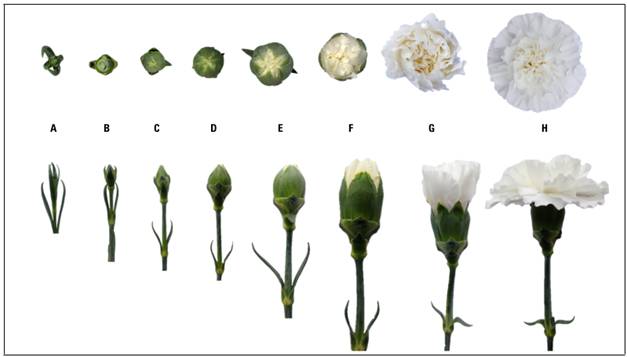
Figure 3. Development stages for flower buds in standard carnation (Dianthus caryophyllus L.) cultivar Moon light. A; rice, B: peas; C: chickpea; D: barrel; E: star; F: bullet; G: cut point 3; H: cut point 5.
In the stage of cut-off point 3, all the petals were developed and had acquired the final color, obtaining the shape of a cup. The Idilio cultivar had pistils, while ‘Ilusion’ and ‘Moon light’ did not (Fig. 1, 2, and 3). The ‘Moon light’ variety present the smallest accumulation with a value of 53.5 GDD, followed by ‘Idilio’, and finally ‘Ilusion’, which was the second shortest instar (Tab. 2). Finally, cut-off point 5 was the shortest stage in all cultivars, with only 33.7 GDD for ‘Ilusion’ (Tab. 2). Because of the action of temperature and the synthesis of ethylene, the petals took on a curvature and reached their maximum opening point (Fig. 1, 2, and 3).
Growth
The behavior of fresh mass
The accumulation of dry mass in the D. caryophyllus, as a function of the GDD, had a sigmoid-type behavior and was adjusted to a logistic model with three parameters (Tab. 3). Three growth phases were observed: phase 1 included the pea stage to the accumulation of 381.5 GDD in the barrel state for the Idilio cultivar (Fig. 4), 381.5 GDD for ‘Ilusion’ (Fig. 5), and 361.6 GDD for ‘Moon light’ (Fig. 6). Phase 2 ended with the bullet stage, where the accumulation was 294.4 GDD, 397.7 GDD, and 293.5 GDD for ‘Idilio’, ‘Ilusion’, and ‘Moon light’, respectively (Fig. 4, 5 and 6). At the end, phase 3 had 108.9 GDD ‘Idilio’, 110.8 GDD ‘Ilusion’, and 99.9 GDD ‘Moon light’, respectively (Fig. 4, 5 and 6). ‘Moon light’ was the earliest cultivar, and ‘Ilusión’ was the latest. A total fresh mass of 10.12±0.16 g was obtained for ‘Idilio’, 11.01±0.60 g for ‘Ilusion’ and 8.54±0.30 g for ‘Moon light’ (Fig. 4, 5 and 6).
Table 3. Estimated parameters of the logistic model for the dry mass of flower buds from three standard carnation (Dianthus caryophyllus) cultivars grown under greenhouse.
| Cultivar | Variable | Model | Estimated parameters* | Data criterion** | |||
|---|---|---|---|---|---|---|---|
| Yasym | K | Tm | AIC | BIC | |||
| Idilio | Dry weight | Logistic | 2.1059 | 0.1050 | 571.09 | -26.92 | -26.60 |
| Fresh weight | 11.300 | 0.0098 | 567.41 | -34.45 | -34.13 | ||
| Ilusion | Dry weight | Logistic | 2.4568 | 0.0060 | 709.61 | -28.33 | -28.01 |
| Fresh weight | 16.315 | 0.0054 | 796.23 | -19.68 | -19.36 | ||
| Moon Light | Dry weight | Logistic | 2.275 | 0.0068 | 655.10 | -34.89 | -34.58 |
| Fresh weight | 12.625 | 0.0066 | 671.61 | -20.71 | -20.39 | ||
*Yasym: asymptotic or maximum Y value, K: inflection point of the curve. Tm: inflection point at which the growth rate is maximized, **AIC: Akaike Information Criterion, and BIC: Bayesian Information Criterion.
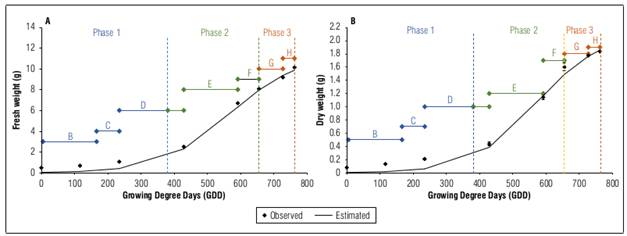
Figure 4. Behavior of fresh mass (A) and dry mass (B) in flower buds from Dianthus caryophyllus cultivar Idilio under greenhouse conditions. The vertical bars at each sampling point indicate the standard error (n=10). B: pea; C: chickpea; D: barrel; E: star; F: bullet; G: cut point 3; and H: cut point 5.
The period between the barrel and star stages had the greatest gain in fresh mass with 4.18 and 3.83 g for the Idilio, and Ilusion cultivars, respectively. In ‘Moon light’ 2.25 g were gained between the chickpea and barrel stages. In the first three stages (rice, peas and chickpeas), logarithmic growth was observed, represented by little accumulation of mass (Fig. 4, 5 and 6). Phase 2 had a greater gain or accumulation of fresh mass for the three cultivars. In ‘Idilio’, 59.8% of the total fresh mass was accumulated in this phase, in ‘Ilusion’, it was 52.4%, and, for ‘Moon light’, 47.76% it was (Fig. 4, 5, and 6). Growth phase 3 represented a non-asymptotic curve for the three cultivars, however, for the curve to stabilize, the flower bud had to reach its maximum point of petal opening (Fig. 4, 5, and 6).
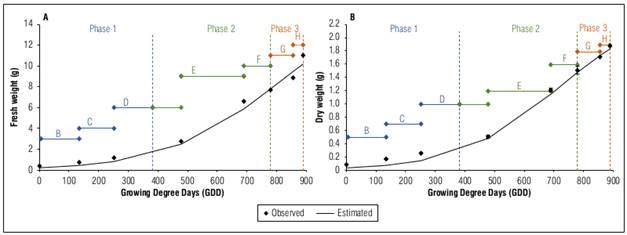
Figure 5. Behavior of fresh mass (A) and dry mass (B) in flower buds from Dianthus caryophyllus cultivar Ilusion under greenhouse conditions. The vertical bars at each sampling point indicate the standard error (n=10). B: pea; C: chickpea; D: barrel; E: star; F: bullet; G: cut point 3; H: cut point 5.
The behavior of dry mass and growth rates
The accumulation of dry mass presented a simple, sigmoid-type behavior, which was adjusted to a logistic model of three parameters (Tab. 2). The first three stages rice, peas and chickpeas were characterized by a low accumulation of dry mass for the three cultivars, which corresponded to logarithmic growth. The greatest accumulation occurred in the period between the barrel and star stages for ‘Idilio’, and ‘Ilusion’, with 0.7 and 0.71 g, respectively, unlike the Moon light cultivar where it occurred between the chickpea and barrel stages with 0.37 g. The total accumulated dry mass was 1.834±0.04 g for ‘Idilio’, 1.885±0.01 g for ‘Ilusion’, and 1.54±0.01 g for ‘Moon light’.
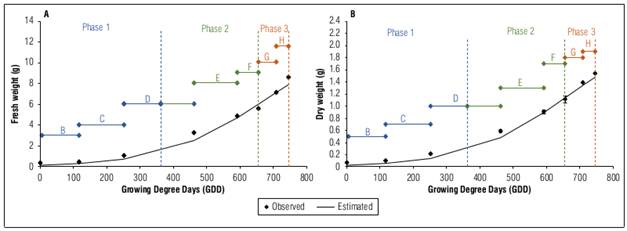
Figure 6. Behavior of fresh mass (A) and dry mass (B) in flower buds from Dianthus caryophyllus cultivar Moon light under greenhouse conditions. The vertical bars at each sampling point indicate the standard error (n=10). B: pea; C: chickpea; D: barrel; E: star; F: bullet; G: cut point 3; H: cut point 5.
The dry mass was related to the accumulation of degree-days for ‘Idilio’ and ‘Ilusion’. The periods of higher accumulation of dry mass did not correspond to the periods with more degree-days, unlike ‘Moon light’, where the transition from chickpea to barrel saw the highest accumulation of dry mass, coinciding with the period of highest accumulation of degree-days (Fig. 4, 5, and 6).
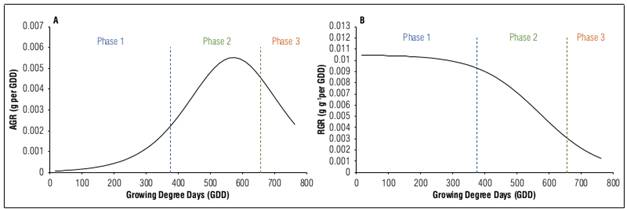
Figure 7. Behavior of the absolute growth rate (AGR) (A) and relative growth rate (RGR) (B) for flower buds from Dianthus caryophyllus cultivar Idilio, under greenhouse conditions.
The AGR for the three cultivars began with a slow increase during the first phase, obtaining very similar values of accumulation of degree-days, with the following values, 380,7 GDD for ‘Idilio’, 381.5 GDD for ‘Ilusion’, and 361.5 GDD for ‘Moon light’. In phase 2, the rate of accumulation of dry mass increased, mainly in ‘Idilio’, which had the highest AGR. In this phase, the decrease in this rate also began. ‘Moon light’ and ‘Ilusion’ showed their maximum value at the end of phase 2 and then started to decline, which was less marked than in ‘Idilio’ (Fig. 7, 8, and 9).
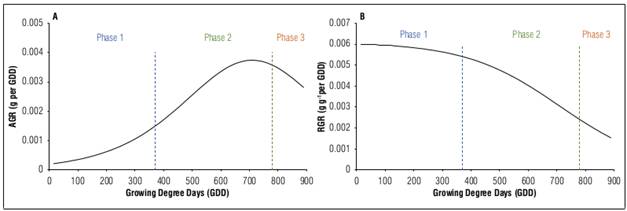
Figure 8. Behavior of the absolute growth rate (AGR) (A) and relative growth rate (B) (below) for flower buds from Dianthus caryophyllus cultivar Ilusion, under greenhouse conditions.
The beginning of the ‘Idilio’ rice stage presented an AGR of 0.000064 g/GDD, and, at the end of its development at cut-off point 5, there was an AGR of 0.0023 g/GDD (Fig. 7). The ‘Ilusion’ rice stage had 0.00021 g/GDD, and point 5 had an AGR of 0.0028 g/GDD (Fig. 8). Finally, ‘Moon light’ had 0.00021 g/GDD in the rice stage and, at the end of its development of the flower bud, had 0.0035 g/GDD (Fig. 9).
The RGR remained more or less stable in phase 1 (rice, pea, and chickpea stages). Idilio presented values almost double that of the other varieties, in which the RGR was similar. In phase 2 (end of chickpea, barrel, star and bullet), a decrease was observed in the 3 varieties, where the decrease was more marked in Idilio. In phase 3 (cutoff point 3 and 5), the decrease continued, and Idilio presented the lowest values. Ilusion and Moonlight presented similar trends (Fig. 7, 8, and 9).
DISCUSSION
Phenology
The Idilio, Ilusion, and Moonlight carnation cultivars had the eight stages of development of the carnation flower bud: rice, pea, chickpea, barrel, star, bullet, cut point 3 and cut point 5 (Fig. 1, 2 and 3). Arévalo et al. (2007) and Romero-Cuervo et al. (2022) identified seven stages in the flower bud of cvs. Nelson and Moonlight. For Japanese markets, the harvest must be done at cut point 3, while for the United States market it should be cut point 5. In this study the stage of development cut point 5 was also included to achieve the stability of the growth curve with a simple sigmoid pattern, a growth pattern characteristic of plants and its organs (Tessmer et al., 2013).
The phenology of the three cultivars was evaluated to predict the approximate time of harvest, as has been reported for carnation cv. Delphi (López et al., 2014) because of the importance of optimal harvests for the international markets, mainly Valentine’s Day. The phenology also is an important tool for planning and carrying out important agronomic activities sustainably, with the purpose that the carnation as a cut flower continues to have the eco-friendly profile, which is associated to low CO2 footprints and environmental outputs (Darras, 2021).
Most of the phenological changes are under genetic control, the development of the carnation flower involves an important number of genes, which would be responsible for determining each of the development stages presented in this study, accordingly, Zhang et al. (2018) reported high expression pattern of the DcaMADSs gene in carnation, five genes in sepal, other five in petals, nine in the ovary, four genes in styles, and six genes in the stamen.
Interestingly, in the first stage (rice), photoassimilates are transported mostly from the leaves to the main button, because the flower is an important sink (Taiz et al., 2018). The time required for this process is largely decisive for the success of each variety because it determines the vase life. In carnations, this is an attractive trait that has been obtained with plant breeding (Onozaki, 2018; Lin et al., 2021).
To obtain a fully developed flower bud from rice point to point 5 (maximum opening), 762 GDD, 889 GDD, and 745.4 GDD were required for ‘Idilio’, ‘Ilusion’, and ‘Moon light’, respectively (Tab. 2). The cultivar that required less GDD and accumulated less dry and fresh mass was ‘Moon light’; this was due to the characteristics of the flower bud, mainly because it has less number of petals (data not shown). This was previously reported by several authors (Trudgill et al., 2005; Parra-Coronado et al., 2016), who stated that the accumulation of GDD to reach the phenological stages differs from cultivar to cultivar. Romero-Cuervo et al. (2022) reported an accumulation of 777.68 GDD for the Moon light cultivar, with one less growth stage (cutoff point 5).
Finally, the cultivars had very different and striking colorations. ‘Idilio’ had red petals, ‘Ilusion’ had pink petals, and ‘Moon light’ had white petals (Fig. 1, 2, and 3). In carnations, colors result from the anthocyanins in the vacuoles of the epidermis of the petals (Morimoto et al., 2020, 2021). Red and dark red carnations mainly accumulate pelargonidin 3-malylglucoside, pink carnations accumulate pelargonidin 3,5-cyclicmalyl-diglucoside (Morimoto et al., 2020), and white carnations do not accumulate or accumulate very few anthocyanins or may accumulate pale yellow flavonoids (Morimoto et al., 2021). For red cultivars such as ‘Idilio’, it is important to apply iron to improve the color of the petals in the bullet and point 3 stages. In this regard, Guo et al. (2022) reported a positive correlation between iron and anthocyanin content in Petunia hybrida.
Color is another highly appreciated characteristic in carnations (Onozaki, 2018) since color is one of the more valuable traits in the markets (Morimoto et al., 2020). Accordingly, the Moon light cultivar is mainly destined for the United States market, followed by Japan, Korea, Russia, Holland, and Canada; a significant percentage is dyed for Russian and Korean markets. ‘Moon light’ has a great track record for its postharvest characteristics such as duration in the vase and good transport and storage conditions. On the other hand, ‘Idilio’ is more appreciated in Russian markets than in the United States and Spain. Generally, the red colored varieties are sent to Russia; however, seasons such as Valentine’s Day, Mother’s Day, and Women’s Day require more in the United States. ‘Ilusion’ also has good storage characteristics, vase-life, and dyeing possibilities, the latter adds value since it opens the possibility of sending flowers to other international markets that prefer colors that have not been generated through plant breeding.
Growth
The fresh and dry masses of the three cultivars were adjusted to a logistic model (Fig. 1, 2, and 3; Tab. 2). This model has been reported in the growth of ‘Moon light’ carnations (Romero-Cuervo et al., 2022), Phalaenopsis orchid (Chen et al., 2019), in lulo (Solanum quitoense) plants (Criollo-Escobar et al., 2020), and in grape (Almanza et al., 2010) and apple fruits (Cepeda et al., 2021) because the logistic model explains simple, sigmoidal growth patterns very well (Pinzón-Sandoval et al., 2021).
Growth in plants or their organs is defined as the increase in dry mass, volume, length, or area that results from cell division, expansion, and differentiation (Lambers et al., 2008). Thus, phase 1 in the 3 carnation cultivars consisted of a phase of low fresh and dry weight gain, which was corroborated with a slow AGR and a stable RGR (Fig. 4, 5, 6, 7, 8 and 9) possibly because this phase has high cell division with a low gain of photoassimilates (Tessmer et al., 2013; Azcón-Bieto and Talón, 2013). Then, a rapid growth phase was observed, where a greater AGR and a marked decrease in RGR were observed in the three materials, which was due to processes of cell elongation and increases in photoassimilates, and water (Azcón-Bieto and Talón, 2013). Finally, growth was at a slower rate, as shown by the AGR and RGR (Fig. 4, 5, 6, 7, 8 and 9). Similar results in AGR and RGR behaviors have been previously reported (Tessmer et al., 2013; Romero-Cuervo et al., 2022). The fresh mass values in the three cultivars were similar to that described for cv. Moon light (Romero-Cuervo et al., 2022), where the total accumulated mass under the climatic conditions (12-14ºC mean temperature) of Ubate (Colombia) was 7.96±0.21 g.
The balance between the assimilates demand of the plant organs and the photosynthetic contribution of the plant must be considered to explain the difference in growth rates between varieties, where ‘Idilio’ had the fastest growth according to the AGR and RGR, and the greatest fresh and dry mass of the flower after ‘Ilusion’ (7, 8 and 9). The latter was similar in the behavior of the rates with ‘Moon light’ but accumulated more GDD and greater fresh and dry mass (Fig. 6, 7, 8 and 9). Ahmad et al. (2017) stated that the AGR is the simplest index of plant growth, and, when comparing similar materials, determining the AGR can be a valuable tool, as was found in the three carnation varieties. AGR is also useful for understanding stem growth in standard carnation cv. Nelson (Baracaldo et al., 2010).
CONCLUSIONS
The stages of carnation flower bud development; rice, pea, chickpea, barrel, star, bullet were characterized in the three cultivars. The state of rice at cut point 5, the Illusion cultivar accumulated 889 GDD, followed by ‘Idilio’ with 762 GDD, and ‘Moon light’ with 745.4 GDD.The longest phenological stage was barrel, while the shortest was cut point 5. The fresh and dry mass of the flower buds in the three cultivars presented a simple, sigmoid flower bud growth pattern that was adjusted to a 3-parameter logistic model. In cut point 5, the maximum fresh weight for ‘Ilusion’ was 11 g, 10.12 for ‘Idilio’, and 8.5 ‘Moon light’.Indicating that ‘Ilusion’ is the later cultivar but with bigger flowers.














